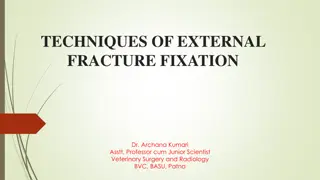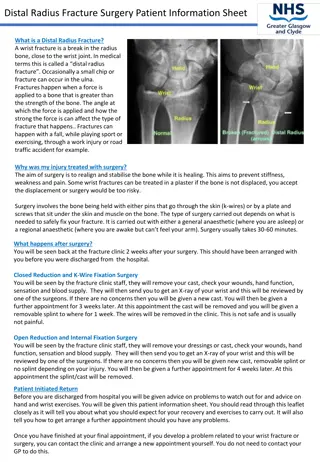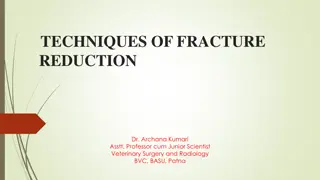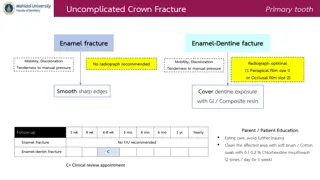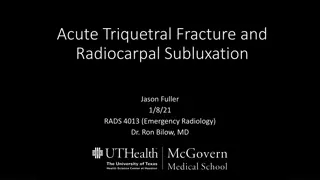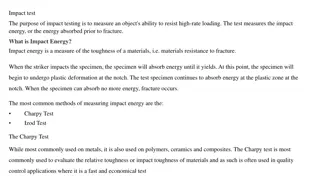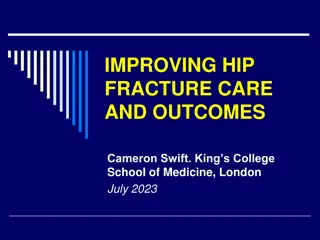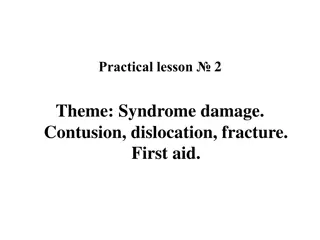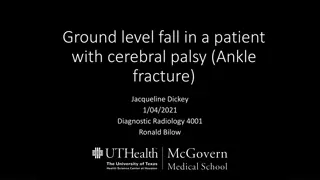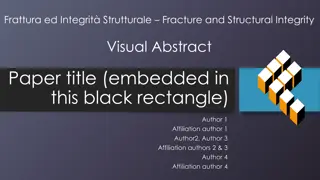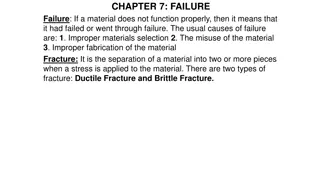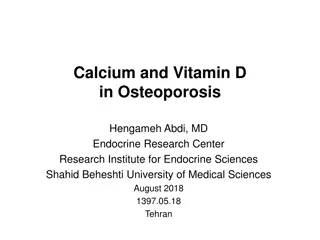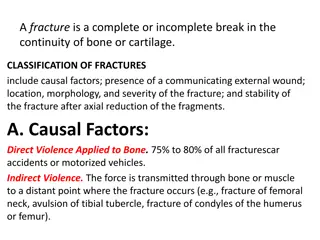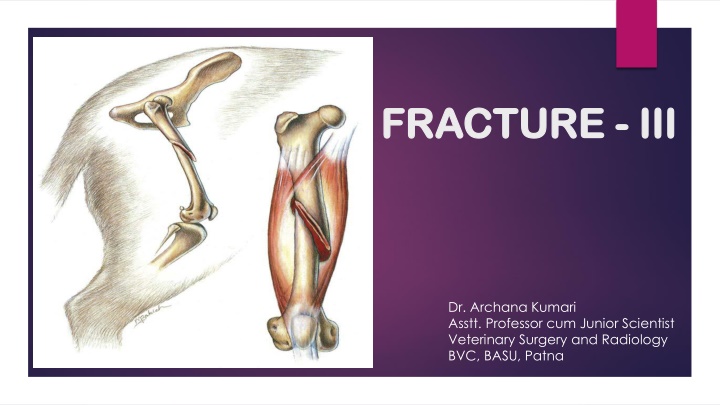
Types and Characteristics of Bone Fractures
Gain insights into different types of bone fractures such as transverse, oblique, spiral, longitudinal, comminuted, multiple, and avulsion based on fracture line direction and stability of fracture fragments. Explore anatomical locations of fractures in bones along with detailed classifications like Salter-Harris types.
Download Presentation

Please find below an Image/Link to download the presentation.
The content on the website is provided AS IS for your information and personal use only. It may not be sold, licensed, or shared on other websites without obtaining consent from the author. If you encounter any issues during the download, it is possible that the publisher has removed the file from their server.
You are allowed to download the files provided on this website for personal or commercial use, subject to the condition that they are used lawfully. All files are the property of their respective owners.
The content on the website is provided AS IS for your information and personal use only. It may not be sold, licensed, or shared on other websites without obtaining consent from the author.
E N D
Presentation Transcript
FRACTURE FRACTURE - - III III . Dr. Archana Kumari Asstt. Professor cum Junior Scientist Veterinary Surgery and Radiology BVC, BASU, Patna
On the Basis of direction Fracture Line Transverse: The fracture line runs transverse to the long axis of bone. Oblique: The fracture line runs oblique to the long axis of the bone. Such type of fracture is caused by bending with axial compression Spiral:The fracture line spirals along the long axis of the bone. Such type of fracture is caused by torsion, twisting or rotational forces e.g. in humerus
Cont. Longitudinal: A fracture extending in longitudinal direction e.g. split pastern. Comminuted:In comminuted fractures, at least three fracture lines inter connect each other at one point Multiple:In multiple fractures, the bone is broken in to three or more segments. The fracture lines of not interconnect each other Avulsion:A fragment of bone at the site of muscle insertion is detached due to its forceful contraction
On the Basis of Stability of Fracture Fragments Stable fracture: The fractured fragments more or less interlock after reduction. Unstable fracture: The fractured fragments are unstable after reduction.
On the Basis of Anatomical Location of Fracture Diaphyseal fracture: Fracture that occur in the diaphysis of a long bone. Metaphyseal fracture (Proximal or Distal):A fracture where within the metaphysis of a long bone Epiphyseal fracture (Proximal or Distal):These are fractures of epiphysis. Fracture of epiphyseal plate: fracture of cartilaginous epiphyseal plate in an immature animals. Based on shape of fracture line it is classified as Salter Harris type I : displacement of epiphysis from the metaphysis at the growth plate Salter Harris type II : separation of small piece of metaphyseal bone along with epiphysis from the metaphysis at the growth plate Salter Harris type III : fracture of epiphysis and a part of the growth plate , but metaphysis is unaffected Salter Harris type IV : fracture through the epiphysis, growth plate and metaphysis Salter Harris type V : impaction of epiphyseal plate with the metaphysis driven into the epiphysis
Fracture of epiphyseal plate: fracture of cartilaginous epiphyseal plate in an immature animals. Based on shape of fracture line it is classified as Salter Harris type I : displacement of epiphysis from the metaphysis at the growth plate Salter Harris type II : separation of small piece of metaphyseal bone along with epiphysis from the metaphysis at the growth plate Salter Harris type III : fracture of epiphysis and a part of the growth plate , but metaphysis is unaffected Salter Harris type IV : fracture through the epiphysis, growth plate and a Salter Harris Type I, b- Salter Harris Type II, c- Salter Harris Type III, d - Salter Harris Type IV e & f - Salter Harris Type V metaphysis Salter Harris type V : impaction of epiphyseal plate with the metaphysis driven into the epiphysis
Cont. Condylar fracture:Fracture of the condyle either medial or lateral or both Supracondylar fracture:Fracture when both the condyles are fractured off the shaft as a unit Supracondylar-intercondylar fracture: The fracture when both the condyles are fractured from the shaft and also from each other ( T shape and Y shape). Articular fracture (Intracapsular): Fracture of subchondral bone and articular cartilage. Periarticular fracture (Extra capsular fracture): A fracture near a joint but not entering within the joint capsule. Trans-cervical fracture: Fracture through neck of femur.
Fracture dislocation: When a fracture of a bone results into joint instability leading to subluxation or luxation of the joint. It is termed as fracture dislocation. The term Monteggia fracture is specifically referred to fracture of the olecranon process and dislocation of the elbow joint Colle s fracture: Fracture of distal end of radius e.g. abduction of paw is noticed in Colle s fracture. Down in the hip: Fracture of the external angle of hip.





